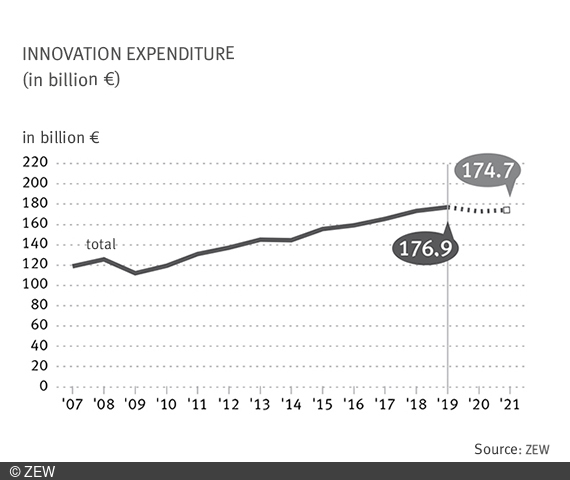German Economy Remains on Course for Innovation Despite the Pandemic
ResearchInnovation expenditure by German companies rose again in 2019, reaching an all-time high of 176.9 billion euros. More and more companies are showing perseverance when it comes to innovation. Compared to the previous year, the share of companies that are continuously active in research and development increased significantly by eight per cent in 2019. This shows that companies are investing in new technologies, products and processes for the long term. The target figures for 2020, which were submitted midyear, are still relatively stable in light of the pandemic. Despite COVID-19, companies in Germany estimate that there will only be a small decrease in innovation spending of 2.2 per cent in contrast to 2019. This is a moderate cut, considering that the decline in economic output in Germany is forecast to be more than five per cent.
These are the key outcomes of the Innovation Survey 2020, conducted by ZEW Mannheim in cooperation with the Institute for Applied Social Sciences (infas) and the Fraunhofer Institute for Systems and Innovation Research on behalf of the German Federal Ministry of Education and Research. The Innovation Survey collects data on the innovation activities for the year under review, 2019, and provides an outlook for the years 2020 and 2021.
“The significance of innovation has once again become more apparent in light of the coronavirus pandemic. Science and technology are helping us find a way out of this crisis. Therefore, I am pleased that German companies have spent more money on innovation than ever before. However, the study also shows us that international competition is getting tougher and that we need to focus our attention on German SMEs in particular. While large companies have been able to keep their innovation budgets relatively stable in 2020, SMEs are expecting their innovation budgets to drop by almost nine per cent.
With tax incentives for R&D, we as the federal government have put in place the right instrument at the right time. The tax incentive will provide essential support for the period of economic upturn and will above all strengthen R&D activities of SMEs. The Agentur für Sprunginnovationen has already begun its work and will provide new impetus in the future,” says Federal Research Minister Anja Karliczek.
“As measured by innovation expenditure, Germany is one of the most innovative countries in the world. It is important that companies focus on innovation also in times of crisis. Only in this way will we be able to successfully bring about structural change through digitalisation and towards a more environmentally friendly economy,” says ZEW President Professor Achim Wambach during an online press conference with the federal research minister.
For the year under review, 2019, a slight growth in innovation spending within the German economy was recorded, totalling 176.9 billion euros. Compared to 2018, this is a rise of 2.1 per cent, which is lower than initially planned. “This indicates that the economic situation had already deteriorated in the year prior to the coronavirus crisis. Current innovation expenditure increased significantly by 6.4 per cent, which includes in particular R&D expenditure,” explains Dr. Christian Rammer, senior researcher at ZEW’s “Economics of Innovation and Industrial Dynamics” Department, as well as project leader of the Mannheim Innovation Panel. By contrast, there was a sharp drop in investments for planned innovation projects (minus 8.8 per cent). This is typical for economic downturns. The rise in innovation expenditure in 2019 was mainly driven by large companies (plus 2.4 per cent), while small and medium-sized enterprises hardly increased their innovation budgets (plus 0.4 per cent).
This development continued further in 2020. Whilst large companies were intent on marginally scaling back on their innovation expenditure despite the COVID-19 pandemic (minus 0.9 per cent), SMEs were planning more vigorous cutbacks (minus 8.7 per cent). In total, innovation expenditure for the German economy is expected to total 173.1 billion euros in 2020 (minus 2.2 per cent compared to 2019). However, a more nuanced picture emerges when looking at the individual sectors. “A positive development can only be observed in the chemical/pharmaceutical and information and communication services sectors. In contrast, business-related service providers, the metal industry, the consumer goods industry and wholesale trade recorded particularly strong declines,” says Christian Rammer.
The target figures for 2021 are marked by great uncertainty. As of mid-2020, the survey shows a slight increase of 0.9 per cent to a total of almost 175 billion euros. Again, it is the large companies that are looking optimistically ahead (plus two per cent), whilst SMEs plan to further scale back their innovation budgets slightly in 2021 (minus five per cent).
The number of companies that implemented product or process innovations remained constant in 2019 at around 182,000. This is equivalent to 54.6 per cent of all companies considered in the Innovation Survey. There was a noticeable increase in the number of companies that conduct R&D on a continuous basis in 2019. These companies totalled 36,500 in 2019, an increase of 8.1 per cent compared to the previous year. This means that 10.9 per cent of all companies were continuously engaged in R&D. This share is particularly high in the chemical and pharmaceutical industry (66 per cent), in the electrical industry (44 per cent) and in mechanical engineering (41 per cent).


